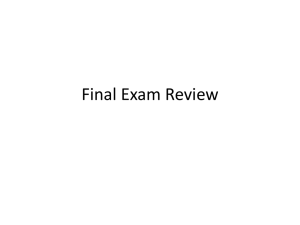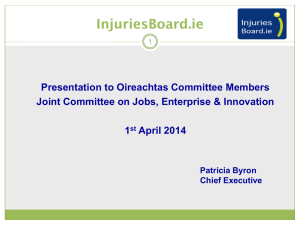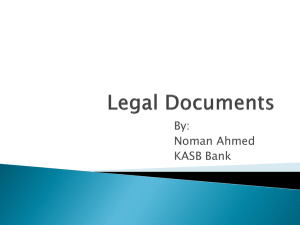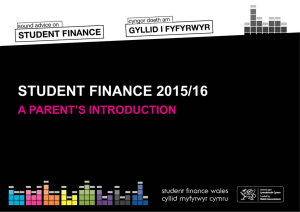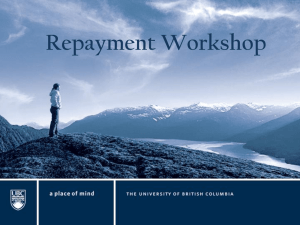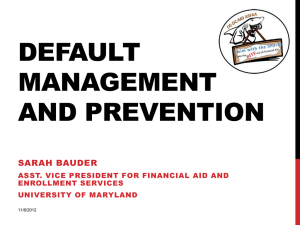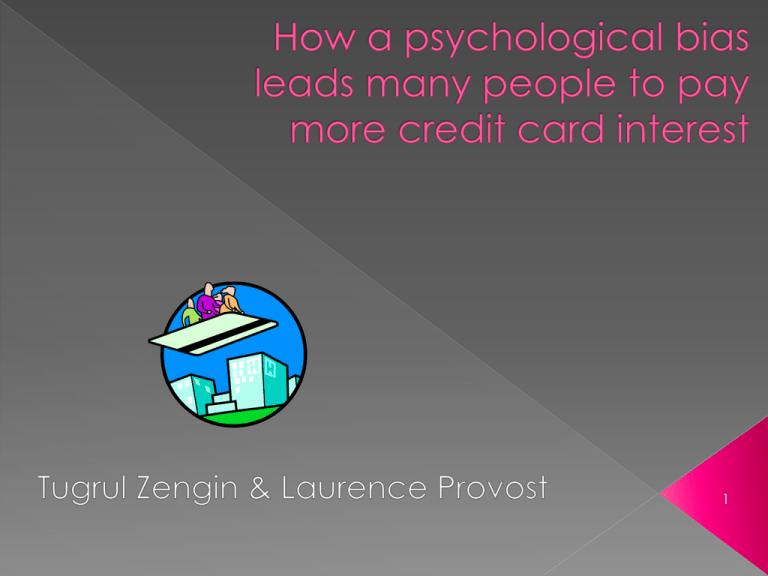
1
Background
Anchoring
Stewart, 2009
› Survey
› Experiment
› Author’s Conclusions
› Limitations
› Implications
› Future Research
o Summary & Conclusions
2
One of the main costs of having a credit card are
the interest charges.
Minimum-repayment is the minimum amount of
money you have to pay on your credit card in
order to avoid further fees.
From April 1st 2011 all credit card companies must
request a minimum monthly repayment from their
customers.
Minimum repayments are usually the total interest
incurred that month.
3
However, the
inclusion of minimum
repayment
information on the
bill may act as a
psychological
anchor.
4
“…people make estimates
by starting from an initial
value that is adjusted to
yield an answer.” – Tversky
and Kahneman (1974)
Tversky, A. & Kahneman, D. (1974). Judgment under
Uncertainty: Heuristics an Biases. Science: New Series,
185(4157), 1124-1131.
5
The study examined the effect of
minimum repayment information as a
psychological anchor.
In order to investigate this the author
conducted a survey and an experiment.
He hypothesised that anchoring
decreases monthly credit card
repayments.
6
Participants were asked about their credit
card repayment behaviour.
All were United Kingdom credit card
holders.
› N: 248
› Age range:18-65
› 50:50 sex ratio
Including:
› Outstanding balance
› Most recent repayment
› The size of the minimum repayment required
7
Repayment Options (n= 248)
Number of Respondents
120
100
80
60
40
20
0
Full Repayment
Partial RepaymentMinimum Repaymet
Figure 1. Bar chart extrapolated from Stewart, N. (2009). The Cost of Anchoring on Credit-Card
Minimum Repayments. Psychological Science, 20(1), 39-41.
8
Number of Respondents
180
160
140
120
100
80
60
40
20
0
Minimum Repayment on bill Minimum Repayment not
on bill
Figure 2. Bar chart extrapolated from Stewart, N. (2009). The Cost of Anchoring on CreditCard Minimum Repayments. Psychological Science, 20(1), 39-41.
9
For partial repayments:
› Positive correlation between minimum
repayment and actual repayment.
› Correlation remained significant when:
The size of balance was accounted for
The people who only made the minimum
repayments were removed from the analysis
Those with balances under £500 were
removed from the analysis
10
Participants received a mock credit card
bill, of £435.76, and were asked to state
how much:
› they could afford to repay
› they would repay
Minimum repayment information, of £5.42,
was either included or omitted.
Participants were recruited from various
sources.
› 97campus visitors
› 215 Web page visitors
› 101 recruited by a market research company
11
Inclusion of
minimum
repayment
information:
› Reduces
payment of all
sizes
Exclusion of
minimum
repayment
information:
› Payment
increase 70%
Figure 3. Taken from: Stewart, N. (2009). The Cost of Anchoring on Credit-Card Minimum
12
Repayments. Psychological Science, 20(1), 39-41.
Inclusion of minimum repayment
information acts as a psychological
anchor.
› This may be costly to the consumer
Warnings about anchoring are
ineffective.
› Alternative repayment scenarios should be
provided.
13
Overly simplified design of experiment.
Focus on United Kingdom and United
States. There are cultural differences in
repayment strategies (Quilgars, Jones, and
Abbott, 2008).
No information about the Socio-economic
status of the participants. This factor has
been shown to influence repayment
strategies (Norvilitis, Merwin, Osberg,
Roehling, Young, & Kamas, 2006).
Quilgars, D., Jones, A,. & Abbott, D. (2008). Does Difference Make a Difference in Financial Planning for Risk? Social
Policy & Administration, 42(6), 576-592.
Norvilitis, J.M., Merwin , M.M., Osberg, T.M., Roehling, P.V., Young, P., & Kamas, M.M. (2006). Personality Factors,
Money Attitudes, Financial Knowledge, and Credit-Card Debt in College Students. Journal of Applied
Social Psychology, 36(6), 1395-1413.
14
“About three quarters of credit-card accounts
attract interest charges. In the United States, creditcard debt is $951.7 billion of a total of $2,539.7 billion
of consumer credit. In the United Kingdom, creditcard debt is $ 55.1 billion of $174.4 billion of consumer
credit”- (Stewart, 2009).
“Warnings about the dangers of making only
minimum repayments…are likely to lead to
disengagement rather than behavior adjustment (cf.
Loewenstein & O’Donoghue,2006)”- (Stewart, 2009).
› Incorrect referencing may reduce perceived validity of
the statements.
Loewenstein, G. & O'Donoghue, T. (2006). "We Can Do This the Easy Way or the Hard Way": Negative
Emotions, Self-Regulation, and the Law. The University of Chicago Law Review, 73(1), 183.
15
Shows a strong relationship between
minimum repayment information and
monthly repayment strategies.
Reinforces the power of anchoring in the
financial sector.
May provide useful information for
legislation of credit cards.
› Leads to the question “In who’s interest is the
minimum repayment legislation?”
16
Following from authors suggestion that
providing a table of alternative
repayment should diminish anchoring:
› Provide participants with three types of bills
1. Including minimum repayment information
2. Excluding minimum repayment information
3. Including a table of detailed alternative
repayment options
› This would show that including a single
alternative payment is the main factor in
psychological anchoring.
17
The effects of anchoring in repayment
strategies in different socio-cultural
groups could be investigated.
Quilgars, Jones, and Abbott (2008)
suggest that differences in culture,
ethnicity, sexual orientation and religion
should be greater understood in the
area of finance.
Quilgars, D., Jones, A,. & Abbott, D. (2008). Does Difference Make a Difference in Financial Planning for
Risk? Social Policy & Administration, 42(6), 576-592.
18
Using the methods suggested above, with a student
population could prove difficult yet rewarding.
› Finding constant anchoring effects across a student
population, would strengthen the findings of Stewart
(2009).
This is because universities have varieties of students
with different:
› Ethnicities,
› Cultural backgrounds,
› Sex orientation
However, students may have different attitudes and
behaviours towards debt management (Chudry, Foxall &
Pallister, 2011).
Thus, findings should be verified by comparing results with a
non-student sample.
Chudry, F., Foxall, G., & Pallister, J. (2011). Exploring Attitudes and Predicting Intentions:
Profiling Student Debtors Using an Extended Theory of Planned Behavior. Journal of Applied
Social Pyschology, 41(1), 119-149.
19
Anchoring is a noticeable issue when
repaying credit card bills.
Stewart (2009) clearly shows this with a
clever study.
This is not a purely hypothetical issue, as it
has an impact on individuals debt
management techniques.
Debt management is a highly salient
issue at the moment.
20
In May, credit card interest rates hit a 13
year high (Insley, 2011).
Norvilitis et al. (2006), suggest that lack of
financial knowledge (amongst other
factors) are related to debt.
› Thus better information about anchoring
should reduce its effects.
Insley, J. (2011, May 5). Credit card interest rates hit 13-year high, analysis shows. The Guardian, Retrieved
November 7, 2011, from http://www.guardian.co.uk/money/2011/may/05/credit-cardinterest-rates-13-year-high.
Norvilitis, J.M., Merwin , M.M., Osberg, T.M., Roehling, P.V., Young, P., & Kamas, M.M. (2006). Personality
Factors, Money Attitudes, Financial Knowledge, and Credit-Card Debt in College Students.
Journal of Applied Social Psychology, 36(6), 1395-1413.
21
Number of Months
Time (in months)
70
60
50
40
30
20
10
0
Min (£52)
125% of
150% of
175% of Double Min
Min (£65) Min (£78) Min (£91)
(£104)
Repayment Strategy
Figure 4. Graph showing example repayment strategies. Calculation made using:
22
http://www.stewart.psych.warwick.ac.uk/decisiontool/
Amount in pounds Sterling
(£)
Total Cost (in £)
3200
3000
2800
2600
2400
2200
2000
Min (£52)
125% of 150% of 175% of Double
Min (£65) Min (£78) Min (£91) Min (£104)
Repayment Strategy
Figure 5. Graph showing example repayment strategies. Calculation made
using: http://www.stewart.psych.warwick.ac.uk/decisiontool/
23
Background
Anchoring
Stewart, 2009
› Survey
› Experiment
› Author’s Conclusions
› Limitations
› Implications
› Future Research
o Summary & Conclusions
24
Chudry, F., Foxall, G., & Pallister, J. (2011). Exploring Attitudes and Predicting Intentions:
Profiling Student Debtors Using an Extended Theory of Planned Behavior. Journal of
Applied Social Pyschology, 41(1), 119-149.
Insley, J. (2011, May 5). Credit card interest rates hit 13-year high, analysis shows. The
Guardian, Retrieved November 7, 2011, from
http://www.guardian.co.uk/money/2011/may/05/credit -card-interest rates-13year-high.
Loewenstein, G. & O'Donoghue, T. (2006). "We Can Do This the Easy Way or the Hard
Way": Negative Emotions, Self-Regulation, and the Law. The University of Chicago
Law Review, 73(1), 183.
Quilgars, D., Jones, A,. & Abbott, D. (2008). Does Difference Make a Difference in
Financial Planning for Risk? Social Policy & Administration, 42(6), 576-592.
Norvilitis, J.M., Merwin , M.M., Osberg, T.M., Roehling, P.V., Young, P., & Kamas, M.M.
(2006). Personality Factors, Money Attitudes, Financial Knowledge, and CreditCard Debt in College Students. Journal of Applied Social Psychology, 36(6), 13951413.
Stewart, N. (2009). The Cost of Anchoring on Credit-Card Minimum Repayments.
Psychological Science, 20(1), 39-41.
Tversky, A. & Kahneman, D. (1974). Judgment under Uncertainty: Heuristics an Biases.
Science: NewSeries, 185(4157), 1124-1131.
25
26

